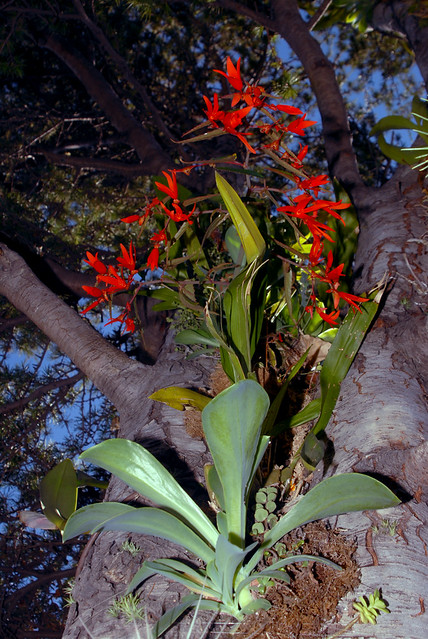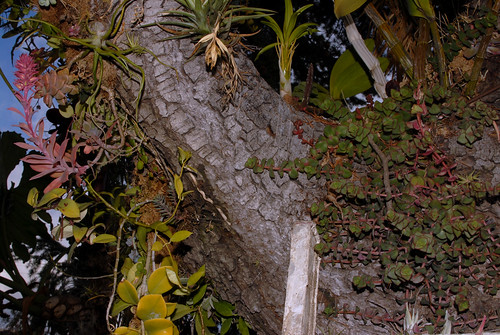A couple years ago my best Brazilian friend, who I've never met in real life, sent me seeds of a few different plants, including a terrestrial Begonia. A terrestrial Begonia? Sometimes I'll say, "If it's not an epiphyte, or a phorophyte, then it's not for me!" There are certainly some epiphytic Begonias, but they are generally pretty thirsty, which doesn't work so well here in parched Southern California. What I've discovered is that plenty of drought tolerant terrestrials can actually make pretty decent epiphytes.
Here's a picture of my tree in 2012...
Begonia boliviensis and Echeveria gibbiflora are both terrestrials. They did well epiphytically... for a while. Each one has the opposite issue. The Begonia's pendent form is perfect for growing on a tree, and it's drought tolerant, but it isn't a drier grower. The Echeveria, on the other hand, is definitely a drier grower. It grows really fast and quickly develops a trunk, which eventually badly bends and causes the plant's gradual decline and eventual demise. So its upright form is far from perfect for growing on a tree. There have been a few rather interesting exceptions. I'd love to speed up the evolutionary process in order to see its optimal epiphytic form.
There are a few mainly epiphytic Echeverias... such as rosea. Here's a picture of it from "The Genus Echeveria" (I think) by John Pilbeam...
So nice!!! Here's a picture of it blooming on my tree in 2012...
It was growing a few other places on the tree as well. They were fine when I watered 3x/week at night during summer, but weren't so fine when I reduced the frequency to 2x/week.
Echeveria rosea's form is much better than gibbiflora's form for growing on trees, but gibbiflora is a much more drier grower than rosea is. It would be wonderful to have the best of both worlds!
In a small section of my garden that I water 3x/week I have some happy roseas growing in baskets and on mossy boards. When two of them bloomed earlier in the year I placed them right next to some blooming gibbifloras and coccineas growing in pots. I was hoping that the hummingbirds would do all the work of cross-pollinating them. Recently I sowed the seeds from the roseas and I'm crossing my fingers that some of the seedlings will be better at growing epiphytically here in SoCal.
My Echeveria strategy is the same one that I've planned on using with the Begonias. I've been on the lookout for drier growing Begonias... so I was really happy that my friend in Brazil sent me some seeds of one. I used water bottles for pots and put pure pumice in some and a mix of pumice and peat in others. On top of the medium I put a layer of New Zealand Sphagnum. I thoroughly watered the pots, sowed the seeds on top of the moss, misted the seeds and put the pots in ziplock bags, which I placed near windows or under lights. When the seedlings started to get too big for the bags, I gradually opened them in order to slowly acclimate the seedlings. Then I placed them outside in a somewhat shady area. I don't think that I lost a single Begonia over the winter. Here's a pic of the seedlings right before I divided and potted them up (13 Aug 2007)...
They look like nasturtiums! They were in a decent amount of shade and weren't very drought stressed. The ferns are all volunteers. They popped up when the pots were in the bags. Some might have come up from the Sphagnum, but some might have also come up from the additional epiphytic moss that I added to the pots. There were also a dozen or so regular Begonias. I'm not exactly sure where they came from.
Here's a pic of the plants after I unpotted them...
I grouped the plants according to their medium. Can you guess which group was in pure pumice? Let's just say that when I potted them up I didn't use pure pumice...
There are around 50 seedlings. I had already given one to Fernando and another to Scadoxus. I placed the Begonias in square pots in a sunnier spot that I water once a week during summer. The Begonias in the water bottle pots went back to their original location.
I'm not exactly sure which species my Begonia is. My friend said venosa but I don't think that they are. Then again, they have been growing in a decent amount of shade. They might look pretty different after getting some direct sun. I believe that my Begonias are from Chapada Diamantina. So I searched Flickr for "Diamantina" and created a gallery for the pics of Begonias. Most of the Begonias look the same but there are a few that look different. What's a little "tricky" is that there are actually two places in Brazil named "Diamantina". In the state of Bahia there's a region called Chapada Diamantina and in the state of Minas Gerais there's a city called Diamantina.
According to this article, my Brazilian Begonia might be Begonia umbraculifera. When I did an image search I found this page with a photo of a Begonia that looks quite similar to mine. What are some other possibilities? A few of the Begonias in my Flickr gallery are identified as Begonia grisea. When I search Google images for Begonia grisea, the fourth image is from an article about Begonia petasitifolia. It looks very different compared to this Begonia petasitifolia. If its leaves unfurled would they look like the leaves on my Begonia?
Whatever my Begonia is, so far it seems to be a decent drier grower. But I doubt that its tall upright form is the best for growing epiphytically. I definitely plan on trying to cross it with Begonias that have a more suitable form, such as boliviensis.






I really enjoyed this article. It will be cool to see what the range of seed/medium/condition will eventually render in terms of both growth and flowering. My curiosity is piqued! Today, I sucessfully explained to a bunch of my fifth graders the wonderous posibility of growing from seeds. They have finally understood what I have been trying to say for a year now. I juxtaposed each of them and their siblings to that of Aloe nyeriensis x kedongensis and Aloe kedongensis x nyeriensis. A lenghty discourse ensued during which each table shared their hypothesis about the traits the offsprings will exhibit. Such rich dialogue between students in grade five can guarantee you that their will be future botanist. Children are naturally curious about many things and we have to provide them with as manny opportunty for discovery. Thanks for the article. It will be on the reading list tomorrow before they sow thier numerous seeds.
ReplyDeleteGlad you enjoyed the entry! Sounds like you had a really great discussion with your students. Hopefully they'll successfully germinate their seeds. I look forward to seeing photos of the seedlings on their blog.
ReplyDeleteIt looks like Pilea peperomioides to me.
ReplyDelete